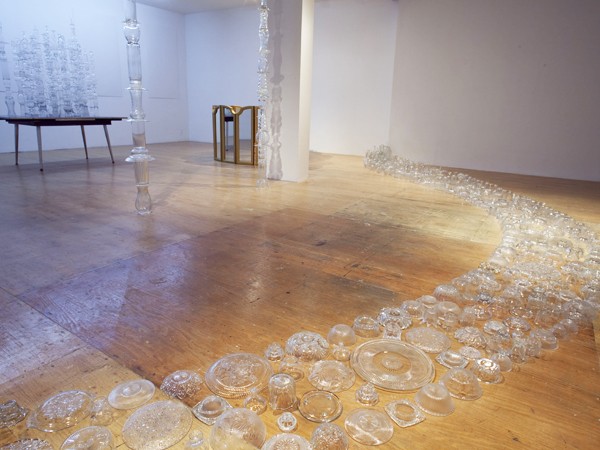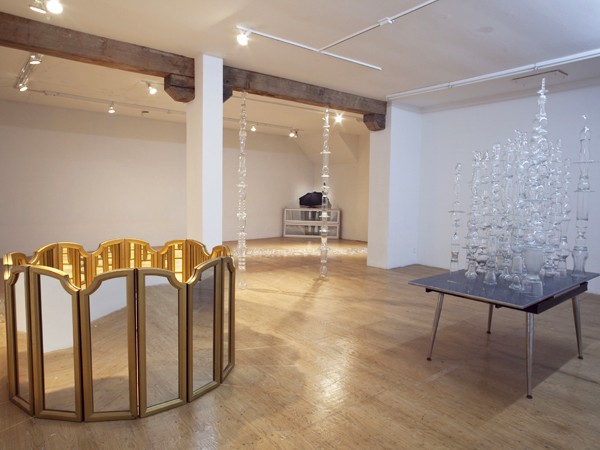The question of taking up a position in space is as much a matter of geography as it is of history. The act of creating a glass city sacrifices intimacy, in favor of the limpidity that characterizes transparency. The act of recreating a memory-city generates a means of positioning oneself that is determined precisely by site and the past. The capacity to see through buildings implies a fragile form of localization. So it was that, in her desire to retrace the city, Sarla Voyer developed an architecture of ‘anti-intimacy’. With private space entirely exposed, so landscape and the horizon remain visible, despite the act of construction. And so the apparent void created by Voyer emphasized the act of laying bare.
The home base; the home town
Voyer’s installation was constructed from objects that are commonly found in everyday domestic settings. From personal items to souvenirs, the objects reconstructed the architectural identity of the artist’s home town. The accumulated glass objects had the effect of holding strangers at a distance from the urban landscape so personal and so precious to Voyer. In effect, she created a ghost city. The audience was able to see through, as well as around, the space, which created the impression that the city was deserted, with only its maker able to truly feel at home; this was an architecture of the infinite.
The artist’s home base was a fragile construction composed of multiple pieces of glass, a mass of souvenirs and secrets containing a world of rediscovery. The act of reconstituting an intimate relationship, of retracing a city, also explored the acts of merging and understanding, creating a dialogue with the mother figure. The various structures within the installation spoke of the numerous possibilities of returning to the cradle, of revisiting the memory of the mother.
In the 20th Century, Walter Benjamin analyzed the relationship between transparency and an absence of habitat, stating that, “habitat must first be understood as a reflection of the period spent at the mother’s breast.”1 On the subject of mobile glass homes designed by Loos and Le Corbusier, Benjamin asserted that, “It is no accident that glass is a hard, smooth material to which nothing can be fixed. A cold and sober material into the bargain. Objects made of glass have no “aura”. Glass is, in general, the enemy of secrets. It is also the enemy of possession.”2 Thus, in Sarla Voyer’s installation we rediscovered the connection between the artist and her mother, between architecture and the maternal breast. In her choice of glass as a material, Voyer opted for a structure that revealed its own interior.
The assemblage of transparent and reflexive objects shaped the lines – or rather the curves – of the architectural and urban elements in Voyer’s labyrinthian city. Her placing of the collection of vases, ashtrays, carafes and glasses mimicked the vocabulary of urban settings. Whether placed horizontally or vertically, representing a pathway or a castle, the usual function of the objects was altered, as the physical characteristics of the items determined their transformation into construction materials. Despite the fact that the objects that Voyer had chosen were transparent, fragile and brittle, the glass forms created a solid exterior that spoke of protection. And so it was that the artist confronted us with an immaterial urban landscape.
A brittle no man’s land
The uninhabitable city that Sarla Voyer created was an unreal space, composed of real elements with connotations of both an intensely affective and practical nature, which spoke of the impossibility of creating an identical reconstruction of souvenirs and of memory. The space of cleanliness and purity in the work took on an identity only through the presence of the audience. The place created by Voyer had neither color nor scent, and offered no means of interaction. The audience were able to look but not touch, to observe without really knowing. We were offered access to a fictional representation of an intimate site. As Gaston Bachelard commented, “To give an object its own poetic space is to give it more space than it has objectively […], it is to follow the expansion of its intimate space.” 3
Voyer’s no man’s land was precarious. It created a tension between stability and collapse. Although the space was described as a city, the work presented an “in-between” zone, somewhere between the artist and the mother figure, intimacy and shared space, the void and an overflow, between the space of the city and that of identity. What we saw before us was both an uninhabited and uninhabitable place. The act of retracing involves following one’s own footsteps, redefining a place by leaving one’s mark, or creating a new trace of oneself. Sarla Voyer’s efforts to retrace the city, her home town, traced the contours of this no mans land, thereby protecting its secret, its silence and its transparency.
Voyer’s city was an invisible city, perceptible only by means of a few curves and contours that alluded to a melee of memories and stories. Her city offered both noise and silence as, in making us of a wealth of found objects, the artist created a true collector’s item.
- Benjamin, Walter. 1986, Paris, capitale du XIXe siècle: Le livre des passages. Paris: Du Cerf editions, 972 p.
- Heyne, Hilde. “Habiter dans une maison de verre”. 2003, in Exposé n.3, Volume 1. Orélans: HYX editions, 280 p.
- Bachelard, Gaston. 1957, La poétique de l’espace. Paris: Les Presses universitaires de France, 215 p.


